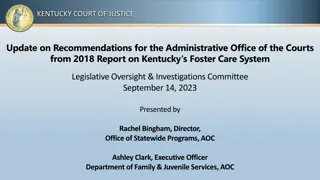
Facts about the Articles of Confederation and Its Limitations
Learn about the Articles of Confederation drafted in 1777 by John Dickinson, its ratification in 1781, the challenges with land disputes, the organization of the A.O.C., the powers of Congress, and the limitations faced by Congress. Understand how the A.O.C. lacked effective power and authority despite its provisions.
Download Presentation

Please find below an Image/Link to download the presentation.
The content on the website is provided AS IS for your information and personal use only. It may not be sold, licensed, or shared on other websites without obtaining consent from the author. If you encounter any issues during the download, it is possible that the publisher has removed the file from their server.
You are allowed to download the files provided on this website for personal or commercial use, subject to the condition that they are used lawfully. All files are the property of their respective owners.
The content on the website is provided AS IS for your information and personal use only. It may not be sold, licensed, or shared on other websites without obtaining consent from the author.
E N D
Presentation Transcript
Articles of Confederation A. A.O.C. drafted 1777 1. John Dickinson- author 2. Ratified 1781
3. Land disputes kept it from being ratified 4. North West Ordinance- ends disputes
B. Organization of A.O.C. 1. No chief executive 2. No national Court system 3. All power reserved to the states
C. Powers of Congress 1. Declare war & make peace 2. Raise army & navy 3. Treaties & foreign alliances
4. Coin & borrow money 5. Regulate weights & measures
6. Establish post office 7. Regulate Indian Affairs
D. Powers denied Congress 1. Power to levy taxes 2. Regulate foreign & domestic trade 3. Settle disputes between states
4. Collect state debts to Congress 5. Enforce any of its powers
In reality, the A.O.C. had no power. It was all bark and no bite. It was a toothless tiger.





